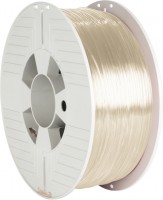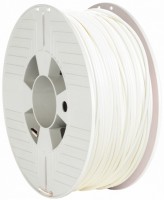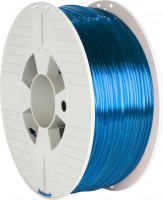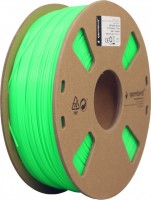3D Printing Materials Verbatim
All models Advanced filters → |
You might be interested in
3D Printing Materials: specifications, types
Material
General type of 3D printing material and its key features. For details, see the relevant help items.
— ABS (Acrylonitrile Butadiene Styrene). One of the most popular modern types of plastic, not only in 3D printing, but in general. The main advantages of ABS are strength, rigidity and durability - according to these criteria, this material is significantly superior to PLA and most photopolymers. At the same time, it is inexpensive. The surface of ABS plastic is glossy, it is usually opaque and can be of any color. Among the disadvantages of the material, there is a rather high melting point (about 230 ° C), which requires strong heating, and an unpleasant odor that occurs during operation. And if the heating is uneven, the finished product may warp or crack—working with ABS plastic often requires heating platforms or other special devices.
- ABS+. An improved version of ABS plastic (see above), which managed to get rid of some of the shortcomings of the original material. The specific features of ABS+ depend on the brand: for example, some compounds are positioned as more elastic and less prone to deformation compared to regular ABS, others are more resistant to solvents (but are easily deformed), etc. These details should be clarified separately in each case.
— ASA (Acrylonitrile Styrene Acrylate). Weather-resistant substitute for ABS plastic (see above). The material is chara...cterized by its durability, resistance to weather conditions and ultraviolet rays. At the same time, it has high impact strength - ASA plastic can withstand mechanical stress without cracking or breaking, making it an excellent choice for outdoor applications. ASA is less susceptible to deformation than some other thermoplastics, and the plastic produces minimal odors during handling. Products made from this material are easily amenable to various post-processing methods, including grinding, turning, painting, gluing and varnishing.
— PLA (Polylactic Acid). A key feature of PLA plastic is its “environmental friendliness”: it is made from natural plant materials, is biodegradable and is considered more environmentally friendly than ABS. Other advantages of this material include a lower melting point, the absence of an unpleasant odor (a faint caramel aroma appears when heated), and the fact that PLA can be translucent and even luminescent (see FPLA). At the same time, finished products made from it are more fragile and less durable than those made from ABS.
- PLA+. A type of biodegradable PLA plastic with a set of additives that go beyond the usual composition. Additives give the material additional properties: a smooth glossy gloss, improved interlayer adhesion, excellent sintering of layers, high tensile and bending strength, reduced mechanical fragility. PLA+ plastic is often odorless. The specific additive formula may vary depending on the type of plastic and the manufacturer of the 3D printing raw materials. Note that some PLA+ filaments can cause nozzle clogging, while other additives increase the required heating temperature. As a result, print settings must be selected empirically for a specific type of PLA+ plastic.
— FPLA (Flexible Polylactic Acid). A modified version of PLA plastic with the addition of fluorene, which makes products made from this material glow in the dark. It has all the advantages of the above-mentioned PLA (see the corresponding paragraph), i.e. it is biodegradable, made from natural raw materials, and has a relatively low melting point. FPLA plastic is used for the manufacture of all kinds of decorative items with luminescence, toys and souvenirs, original jewelry, etc.
— TPE (Thermoplastic Elastomer). Thermoplastic elastomer combining the properties of plastic and rubber. TPE has high elasticity and flexibility, which allows this material to be used to create flexible and resilient parts that can deform under pressure and return to their original shape. It is used for the manufacture of seals and gaskets, elastic parts of toys, shoes, covers for mobile gadgets, automobile parts (including interior elements and tires). TPE is characterized by anti-allergenic properties, scratch resistance, and good adhesive properties.
— TPU (Thermoplastic Polyurethane). A type of thermoplastic polyurethane used in 3D printing to produce a wide range of different products. This material is quite strong with high flexibility and elasticity, and when cooled it practically does not shrink. The tactile sensations of products made from TPU plastic are reminiscent of polyurethane soles on shoes. Among other features of the material, it is important to note its chemical resistance to gasoline, motor oils, alcohol and other solvents, but this also has a downside - TPU plastic is practically impossible to paint. This material also has increased hygroscopic properties, so it must be protected from the external environment and proper storage conditions must be observed (it is advisable to keep the plastic in a closed container with dry silica gel).
— TPR (Thermoplastic Rubber). Filament for 3D printing, which is a synthetic polymer with the properties of plastic and rubber. The material is characterized by high wear resistance and enhanced mechanical strength compared to traditional TPU and TPE (see relevant paragraphs). TPR plastic has an extrusion temperature of 230 to 270 °C and is suitable for the manufacture of a wide range of products - from prototyping to finished products.
— PETG (Polyethylene Terephthalate Glycol). PETG plastic combines the strength characteristics of ABS and the versatility of PLA. When hot printing, such plastic practically does not shrink; the layers stick together well and are not deformed. Based on it, you can create high-precision products of almost any size. PETG is an improved version of the classic PET plastic. The improvement consists of additional saturation of the material with glycol, as a result of which the plastic becomes less brittle and its heat resistance significantly increases. PETG is a non-toxic material and can be used in the production of food containers. The extrusion temperature is in the range of 200 – 230 °C. This type of plastic is resistant to many alkalis, acids and saline solutions.
- PCTG (Polycyclohexylenedimethylene Terephthalate Glycol). The plastic is from the family of glycol-modified polyesters, like the PETG discussed above (see the corresponding paragraph). However, in comparison, PCTG boasts increased strength, toughness and transparency. The material practically does not shrink when cooled and is able to withstand much stronger impacts than products made from similar plastics, while maintaining the same tensile strength and heat resistance. PCTG is recommended for 3D printing of housings for measuring instruments, lamps, elements of hand tools, etc.
- Flex. A type of thermoplastic based on polyurethane. A distinctive feature of the material is the flexibility and elasticity of the finished products - hence the name (“flex” is translated from English as “flexible”). In terms of its properties, Flex is often compared with solid silicone: it is not afraid of impacts, insensitive to oil, gasoline and many other aggressive liquids, wear-resistant and durable (except that the operating temperature for finished products made from this type of plastic is lower than that of silicone, and is average up to 100 °C).
— PCL (Polycaprolactone). Biodegradable plastic PCL (polycaprolactone) is a suitable filament for 3D pens with low extrusion temperature. It reaches a plastic state at temperatures up to 60 ° C, making it the safest among materials for handles with a hot operating principle. In addition, reusable use of such plastic is allowed: for reuse, it is enough to soften the finished product in hot water. Crafts made from PCL plastic have a glossy surface, the hardened material is quite elastic and flexible.
— HIPS (High Impact Polystyrene). HIPS plastic is a mixture of polybutadiene and polystyrene. In terms of properties, it is a cross between ABS and PLA. The material combines good strength, elasticity and ease of post-processing: HIPS can be puttyed and painted, it can be easily machined. In addition, this type of plastic is non-degradable, which makes 3D printed products reliable and durable. The material is not afraid of moisture and can be left outdoors for a long time. The melting point is in the range of 230 – 260 °C. The material does not exhibit toxic properties, which allows it to be used in the production of food utensils and packaging.
- Nylon. Nylon has been used relatively recently in 3D printing, which is why it is less common than other popular thermoplastics. Compared to traditional ABS (see the corresponding paragraph), this material requires higher temperatures, emits more harmful substances, and in finished form tends to accumulate moisture and lose strength, which puts forward certain restrictions on use. On the other hand, nylon products are not so hard, which in some cases is an advantage - in particular, for medical applications: splints and prostheses with a characteristic mesh structure that combine lightness and strength can be printed from such material.
— Photopolymer resin. Liquid photopolymer materials that harden under the influence of ultraviolet radiation. One of the key advantages of such materials is that they do not require heating to use, and finished products made from photopolymer resin will not have the characteristic stripes from a 3D printer extruder. Complex shapes can be easily made from photopolymers (for example, for use in medicine), and there is no unpleasant odor when working with them. On the other hand, such filaments are much more expensive than traditional thermoplastics like ABS, PLA and others.
— ABS (Acrylonitrile Butadiene Styrene). One of the most popular modern types of plastic, not only in 3D printing, but in general. The main advantages of ABS are strength, rigidity and durability - according to these criteria, this material is significantly superior to PLA and most photopolymers. At the same time, it is inexpensive. The surface of ABS plastic is glossy, it is usually opaque and can be of any color. Among the disadvantages of the material, there is a rather high melting point (about 230 ° C), which requires strong heating, and an unpleasant odor that occurs during operation. And if the heating is uneven, the finished product may warp or crack—working with ABS plastic often requires heating platforms or other special devices.
- ABS+. An improved version of ABS plastic (see above), which managed to get rid of some of the shortcomings of the original material. The specific features of ABS+ depend on the brand: for example, some compounds are positioned as more elastic and less prone to deformation compared to regular ABS, others are more resistant to solvents (but are easily deformed), etc. These details should be clarified separately in each case.
— ASA (Acrylonitrile Styrene Acrylate). Weather-resistant substitute for ABS plastic (see above). The material is chara...cterized by its durability, resistance to weather conditions and ultraviolet rays. At the same time, it has high impact strength - ASA plastic can withstand mechanical stress without cracking or breaking, making it an excellent choice for outdoor applications. ASA is less susceptible to deformation than some other thermoplastics, and the plastic produces minimal odors during handling. Products made from this material are easily amenable to various post-processing methods, including grinding, turning, painting, gluing and varnishing.
— PLA (Polylactic Acid). A key feature of PLA plastic is its “environmental friendliness”: it is made from natural plant materials, is biodegradable and is considered more environmentally friendly than ABS. Other advantages of this material include a lower melting point, the absence of an unpleasant odor (a faint caramel aroma appears when heated), and the fact that PLA can be translucent and even luminescent (see FPLA). At the same time, finished products made from it are more fragile and less durable than those made from ABS.
- PLA+. A type of biodegradable PLA plastic with a set of additives that go beyond the usual composition. Additives give the material additional properties: a smooth glossy gloss, improved interlayer adhesion, excellent sintering of layers, high tensile and bending strength, reduced mechanical fragility. PLA+ plastic is often odorless. The specific additive formula may vary depending on the type of plastic and the manufacturer of the 3D printing raw materials. Note that some PLA+ filaments can cause nozzle clogging, while other additives increase the required heating temperature. As a result, print settings must be selected empirically for a specific type of PLA+ plastic.
— FPLA (Flexible Polylactic Acid). A modified version of PLA plastic with the addition of fluorene, which makes products made from this material glow in the dark. It has all the advantages of the above-mentioned PLA (see the corresponding paragraph), i.e. it is biodegradable, made from natural raw materials, and has a relatively low melting point. FPLA plastic is used for the manufacture of all kinds of decorative items with luminescence, toys and souvenirs, original jewelry, etc.
— TPE (Thermoplastic Elastomer). Thermoplastic elastomer combining the properties of plastic and rubber. TPE has high elasticity and flexibility, which allows this material to be used to create flexible and resilient parts that can deform under pressure and return to their original shape. It is used for the manufacture of seals and gaskets, elastic parts of toys, shoes, covers for mobile gadgets, automobile parts (including interior elements and tires). TPE is characterized by anti-allergenic properties, scratch resistance, and good adhesive properties.
— TPU (Thermoplastic Polyurethane). A type of thermoplastic polyurethane used in 3D printing to produce a wide range of different products. This material is quite strong with high flexibility and elasticity, and when cooled it practically does not shrink. The tactile sensations of products made from TPU plastic are reminiscent of polyurethane soles on shoes. Among other features of the material, it is important to note its chemical resistance to gasoline, motor oils, alcohol and other solvents, but this also has a downside - TPU plastic is practically impossible to paint. This material also has increased hygroscopic properties, so it must be protected from the external environment and proper storage conditions must be observed (it is advisable to keep the plastic in a closed container with dry silica gel).
— TPR (Thermoplastic Rubber). Filament for 3D printing, which is a synthetic polymer with the properties of plastic and rubber. The material is characterized by high wear resistance and enhanced mechanical strength compared to traditional TPU and TPE (see relevant paragraphs). TPR plastic has an extrusion temperature of 230 to 270 °C and is suitable for the manufacture of a wide range of products - from prototyping to finished products.
— PETG (Polyethylene Terephthalate Glycol). PETG plastic combines the strength characteristics of ABS and the versatility of PLA. When hot printing, such plastic practically does not shrink; the layers stick together well and are not deformed. Based on it, you can create high-precision products of almost any size. PETG is an improved version of the classic PET plastic. The improvement consists of additional saturation of the material with glycol, as a result of which the plastic becomes less brittle and its heat resistance significantly increases. PETG is a non-toxic material and can be used in the production of food containers. The extrusion temperature is in the range of 200 – 230 °C. This type of plastic is resistant to many alkalis, acids and saline solutions.
- PCTG (Polycyclohexylenedimethylene Terephthalate Glycol). The plastic is from the family of glycol-modified polyesters, like the PETG discussed above (see the corresponding paragraph). However, in comparison, PCTG boasts increased strength, toughness and transparency. The material practically does not shrink when cooled and is able to withstand much stronger impacts than products made from similar plastics, while maintaining the same tensile strength and heat resistance. PCTG is recommended for 3D printing of housings for measuring instruments, lamps, elements of hand tools, etc.
- Flex. A type of thermoplastic based on polyurethane. A distinctive feature of the material is the flexibility and elasticity of the finished products - hence the name (“flex” is translated from English as “flexible”). In terms of its properties, Flex is often compared with solid silicone: it is not afraid of impacts, insensitive to oil, gasoline and many other aggressive liquids, wear-resistant and durable (except that the operating temperature for finished products made from this type of plastic is lower than that of silicone, and is average up to 100 °C).
— PCL (Polycaprolactone). Biodegradable plastic PCL (polycaprolactone) is a suitable filament for 3D pens with low extrusion temperature. It reaches a plastic state at temperatures up to 60 ° C, making it the safest among materials for handles with a hot operating principle. In addition, reusable use of such plastic is allowed: for reuse, it is enough to soften the finished product in hot water. Crafts made from PCL plastic have a glossy surface, the hardened material is quite elastic and flexible.
— HIPS (High Impact Polystyrene). HIPS plastic is a mixture of polybutadiene and polystyrene. In terms of properties, it is a cross between ABS and PLA. The material combines good strength, elasticity and ease of post-processing: HIPS can be puttyed and painted, it can be easily machined. In addition, this type of plastic is non-degradable, which makes 3D printed products reliable and durable. The material is not afraid of moisture and can be left outdoors for a long time. The melting point is in the range of 230 – 260 °C. The material does not exhibit toxic properties, which allows it to be used in the production of food utensils and packaging.
- Nylon. Nylon has been used relatively recently in 3D printing, which is why it is less common than other popular thermoplastics. Compared to traditional ABS (see the corresponding paragraph), this material requires higher temperatures, emits more harmful substances, and in finished form tends to accumulate moisture and lose strength, which puts forward certain restrictions on use. On the other hand, nylon products are not so hard, which in some cases is an advantage - in particular, for medical applications: splints and prostheses with a characteristic mesh structure that combine lightness and strength can be printed from such material.
— Photopolymer resin. Liquid photopolymer materials that harden under the influence of ultraviolet radiation. One of the key advantages of such materials is that they do not require heating to use, and finished products made from photopolymer resin will not have the characteristic stripes from a 3D printer extruder. Complex shapes can be easily made from photopolymers (for example, for use in medicine), and there is no unpleasant odor when working with them. On the other hand, such filaments are much more expensive than traditional thermoplastics like ABS, PLA and others.
Package
The type of packaging in which the 3D printing filament is supplied.
— Coil. Packaging in the form of a plastic or cardboard reel that allows you to easily unwind the filament during 3D printing. The spool is a cylindrical drum with side disks, and usually has a hole in its center for mounting on a 3D printer holder. This type of packaging allows you to conveniently store and use plastic filaments, preventing them from tangling and ensuring a uniform supply of filament.
- Skein. A scroll or ball of plastic for 3D printing without a rigid frame and side disks - this is the main difference between a skein of filament and a package in the form of a reel (see above).
- Rods. A set of several refills - consumables mainly for 3D pens. Consumables for such tools are traditionally sold in sets, and the rods in them can be either single-color or multi-colored.
- Bottle. Bottle-shaped packaging may be designed to hold certain types of filament, such as viscous and semi-liquid photopolymer resin. Bottles are usually made opaque to protect the contents from ultraviolet rays. Also, such packaging provides reliable protection of the filament from other external influences (in particular, moisture).
— Coil. Packaging in the form of a plastic or cardboard reel that allows you to easily unwind the filament during 3D printing. The spool is a cylindrical drum with side disks, and usually has a hole in its center for mounting on a 3D printer holder. This type of packaging allows you to conveniently store and use plastic filaments, preventing them from tangling and ensuring a uniform supply of filament.
- Skein. A scroll or ball of plastic for 3D printing without a rigid frame and side disks - this is the main difference between a skein of filament and a package in the form of a reel (see above).
- Rods. A set of several refills - consumables mainly for 3D pens. Consumables for such tools are traditionally sold in sets, and the rods in them can be either single-color or multi-colored.
- Bottle. Bottle-shaped packaging may be designed to hold certain types of filament, such as viscous and semi-liquid photopolymer resin. Bottles are usually made opaque to protect the contents from ultraviolet rays. Also, such packaging provides reliable protection of the filament from other external influences (in particular, moisture).
Diameter
The diameter of the filament must match the size of the extruder nozzle. There are several common types of extruders: for 1.75, 2.85 and 3 mm filaments. At the same time, different extruder standards are not interchangeable with each other. 1.75 mm filaments are primarily used for more precise printing of small parts, while 2.85 and 3 mm filaments are used in higher productivity 3D printing.
Length
The total length of filament in the package, expressed in meters. Note that what is meant here is the total length of the entire 3D plastic - if the standard delivery set includes 10 multi-colored skeins of thread of 20 m each, then for such a set the length is indicated as 200 m.
Quantity
Total number of rods in the package. Note that what is meant here is the total number - if the conditional delivery set includes 3 sets of multi-colored rods of 25 pcs each, then the quantity indicated for it is 75 pcs.
Print speed
Recommended print speed of the material in millimeters, recommended by the filament manufacturer. Different types of thermoplastic have different characteristics, which directly affects the printing speed. However, the higher this value, the faster the printer is able to cope with a particular task.
Melting temperature
The recommended temperature at which a material changes from a solid to a viscous fluid state. This is what allows it to be extruded through a printer nozzle to create three-dimensional objects. Each type of plastic has its own specific melting point, which is critical to ensure successful printing.
Extrusion temperature
Recommended temperature of a 3D printer extruder (nozzle) for working with a particular type of thermoplastic. For example, PLA material requires temperatures of about 180 – 230 °C, ABS will require 220 – 250 °C, and polycarbonate will require at least 270 °C.
Table / platform temperature
Recommended 3D printer bed heating temperature for using a specific type of thermoplastic. So, for printing with PLA plastic it should be in the range of up to 100 °C, for working with ABS plastic and nylon - in the range from 100 °C to 120 °C, and polycarbonate and refractory types of plastic can be used on high-temperature platforms.









